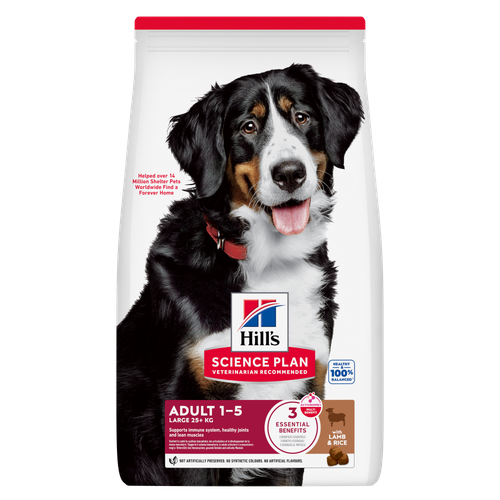
-
Find the right food for your petTake this quiz to see which food may be the best for your furry friend.Find the right food for your petTake this quiz to see which food may be the best for your furry friend.Featured products
 Perfect Digestion Small & Mini Adult Dog Food
Perfect Digestion Small & Mini Adult Dog FoodHill's Science Plan Perfect Digestion Small & Mini Breed Adult Dog Food with Chicken & Brown Rice supports ultimate digestive well-being & a healthy microbiome.
Shop Now Small & Mini Mature Adult 7+ Dog Food
Small & Mini Mature Adult 7+ Dog FoodHill's Science Plan Small & Mini Breed Mature Adult Dog Food with Chicken is a complete pet food, specially formulated with ActivBiome+ Multi-Benefit Technology.
Tailored nutrition to support graceful ageing in small dogs. Specially made with a synergistic blend of nutrients for energy & vigor.Shop Now Perfect Digestion Large Breed Puppy Food
Perfect Digestion Large Breed Puppy FoodPrecisely balanced nutrition with Hill's ActivBiome+ prebiotic blend actively contributes to supporting digestive health and overall well-being to help your pet feel their best
Shop NowFeatured products Kitten Food
Kitten FoodTender chicken chunks in gravy for kittens, with omega-3s for healthy eye & brain development and high-quality protein to support muscle growth. With balanced minerals to promote strong bones & teeth.
Shop Now Hypoallergenic Dry Cat Food
Hypoallergenic Dry Cat FoodHILL'S SCIENCE PLAN Hypoallergenic Adult cat food with egg & insect protein is a complete pet food for adult cat 1–6 years old. It's formulated for cats with delicate skin and stomach, with limited high quality novel protein sources & no grain.
Shop Now Hairball & Perfect Coat Adult Cat Food
Hairball & Perfect Coat Adult Cat FoodHill's Science Plan HAIRBALL & PERFECT COAT Adult cat food with Chicken is specially formulated to effectively help avoid hairball formation in adult cats while promoting a beautiful coat. Thanks to its mix of essential Omega-6 fatty acids, this food benefits the cat's skin and fur keeping them healthy and shiny. Our Advanced Fibre Technology helps reduce hairballs by naturally promoting their passage through the gut. This food is formulated with high-quality protein for a perfectly balanced, great-tasting recipe.
Shop Now -
Dog
- Dog Tips & Articles
-
Health Category
- Weight
- Food & Environmental Sensitivities
- Urinary
- Digestive
- Joint
- Kidney
-
Life Stage
- Puppy Nutrition
- Adult Nutrition
- Senior Nutrition
Cat- Cat Tips & Articles
-
Health Category
- Weight
- Skin & Food Sensitivities
- Urinary
- Digestive
- Kidney
-
Life Stage
- Kitten Nutrition
- Adult Nutrition
Featured articles Understanding Your Pet's Microbiome
Understanding Your Pet's MicrobiomeLearn what a pet's microbiome is, how it contributes to your pet's gut & overall health, and why nutrition is important in maintaining healthy microbiomes.
Read More Pet Food Storage Tips
Pet Food Storage TipsWhere you store your cat and dog food can make a big difference in the quality and freshness once it is opened. Here are some common questions and recommendations for optimal storage for all of Hill’s dry and canned cat and dog food.
Read More The Right Diet For Your Pet
The Right Diet For Your PetLearn what to look for in healthy pet food & nutrition, including ingredients, quality of the manufacturer, your pet's age, and any special needs they have
Read More -


Some dog parents confuse arthritis with hip dysplasia but, unlike arthritis, hip dysplasia in dogs develops when a dog is young. Read on to learn everything you need to know about this condition.
What Is Hip Dysplasia in Dogs?
Canine hip dysplasia arises during a dog's juvenile growth phase and results from a malformed hip joint. According to the Cornell University College of Veterinary Medicine, hip dysplasia is the most common orthopaedic condition in medium and large breed dogs, with an incidence rate of more than 70 percent in some pure breeds.
In dogs with canine hip dysplasia, parts of the hip joint grow at different rates, leading to instability and looseness. This instability allows excess movement and abnormal bony rubbing, which causes pain and even small fractures.
Signs of Canine Hip Dysplasia
One of the first clues your dog may be suffering from hip dysplasia is if they're reluctant to rise from a sitting or lying position. This behaviour can be seen in puppies as young as a few months old but is most common in dogs less than 2 years old.
Lameness resulting from hip dysplasia in dogs is usually chronic and progresses slowly. Thus, lameness isn't always a primary sign of the condition. Instead, dogs may show signs of exercise intolerance or weakness. When your veterinarian examines your dog's hips, they'll watch for indicators of pain or resistance to pressure.
Your dog likely doesn't have hip dysplasia if their lameness begins suddenly or progresses rapidly, the lameness is severe, they can't move well on their rear legs or if they have an uncoordinated gait.


Tasty Tips
What Causes It?
The American College of Veterinary Surgeons explains that there are two primary causes of hip dysplasia in dogs: genetics and nutrition. While genetics determine whether a dog develops hip dysplasia, nutritional research shows that consuming food that's too high in calcium or calories also plays a role in the condition's development.
Although any dog can be affected, hip dysplasia is typically seen in larger dogs, such as German shepherds, Saint Bernards, mastiffs, rottweilers, Labrador retrievers, golden retrievers, Old English sheepdogs and bulldogs . Mixed-breed dogs are also at risk.
If you have a medium, large or giant breed puppy, you can reduce their risk of developing the condition by feeding them a balanced puppy food designed for large breeds. Also, help them to avoid rapid weight gain during their first year of life. Make sure to talk to your veterinarian about your dog's food, and have them recommend one that would be best for your dog's growth and development.

How Is It Diagnosed?
Your vet will likely screen for hip dysplasia during your dog's regular checkup. They do this by evaluating your dog's gait and examining their body for signs of pain.
Because the condition can cause hip muscles to atrophy, your vet may X-ray the area, if suspected.
What Treatments Are Available?
Minimally affected dogs may benefit from nonsteroidal anti-inflammatory drugs. Most vets also recommend over-the-counter joint supplements containing glucosamine and chondroitin sulphate. Be sure to ask your veterinarian about dog foods that are specially formulated for mobility health that contain many of the same joint health nutrients that these supplements contain.
If your dog is overweight, you'll want to make a weight-loss plan right away, as reducing the weight-bearing load and friction upon the joints will likely improve your dog's mobility and comfort. Your veterinarian can help determine the best method, including a proper nutrition plan (including potentially switching to a dog food formulated for getting your dog to the proper weight) and exercise as long as your dog can tolerate it with the stress on their hips.
If your dog is severely affected, surgery may be the best option. Several surgical procedures are available to treat canine hip dysplasia, with the most common being total hip replacement and femoral head ostectomy. Your vet will work with you to choose the best procedure for your dog and may refer you to a board-certified veterinary surgeon.
There are also a plethora of new alternative therapies. Biologic therapeutics, such as platelet-rich plasma therapy and stem cell therapy, are now available in veterinary clinics across the nation. Many dog parents and vets alike find that such therapeutics provide temporary relief — albeit of varying degrees. Acupuncture and laser therapy are also popular adjunctive treatments. Your veterinarian will be to help you determine the best course of treatment for your dog's particular condition.
If you think your dog might be showing signs of hip dysplasia, talk to your vet today and have your pet diagnosed.


Dr. Laci Schaible is a small animal veterinarian, veterinary journalist, and a thought leader in the industry. She received her Doctor of Veterinary Medicine from Texas A&M University and her Masters in Legal Studies from Wake Forest University.
Related products

Hill's Science Plan Large Breed Adult Dog Food with Lamb & Rice is a complete pet food, specially formulated with ActivBiome+ Multi-Benefit Technology.
This food is specifically designed to fuel the energy needs of large breed dogs during the prime of their life.

Hill's Science Plan Perfect Digestion Small & Mini Breed Adult Dog Food with Chicken & Brown Rice supports ultimate digestive well-being & a healthy microbiome.

Hill's Science Plan Small & Mini Breed Mature Adult Dog Food with Chicken is a complete pet food, specially formulated with ActivBiome+ Multi-Benefit Technology.
Tailored nutrition to support graceful ageing in small dogs. Specially made with a synergistic blend of nutrients for energy & vigor.

Precisely balanced nutrition with Hill's ActivBiome+ prebiotic blend actively contributes to supporting digestive health and overall well-being to help your pet feel their best
Related articles

Discover how the field of dog science is giving us more and more insights into the inner workings of our furry best friends.

Discover the causes, signs, and treatments of kidney disease in dogs and find methods of supporting your dog's kidney health. Learn more at Hill's Pet South Africa.

Learn about snake bites on dogs, including clinical symptoms to look for, what to do if you think your dog was bitten, and treatment & prevention options.

Dog obesity is a significant problem - learn more about helping your dog become trimmer and healthier through improved nutrition.

Put your dog on a diet without them knowing
Our low calorie formula helps you control your dog's weight. It's packed with high-quality protein for building lean muscles, and made with purposeful ingredients for a flavorful, nutritious meal. Clinically proven antioxidants, Vitamin C+E, help promote a healthy immune system.
Put your dog on a diet without them knowing
Our low calorie formula helps you control your dog's weight. It's packed with high-quality protein for building lean muscles, and made with purposeful ingredients for a flavorful, nutritious meal. Clinically proven antioxidants, Vitamin C+E, help promote a healthy immune system.

